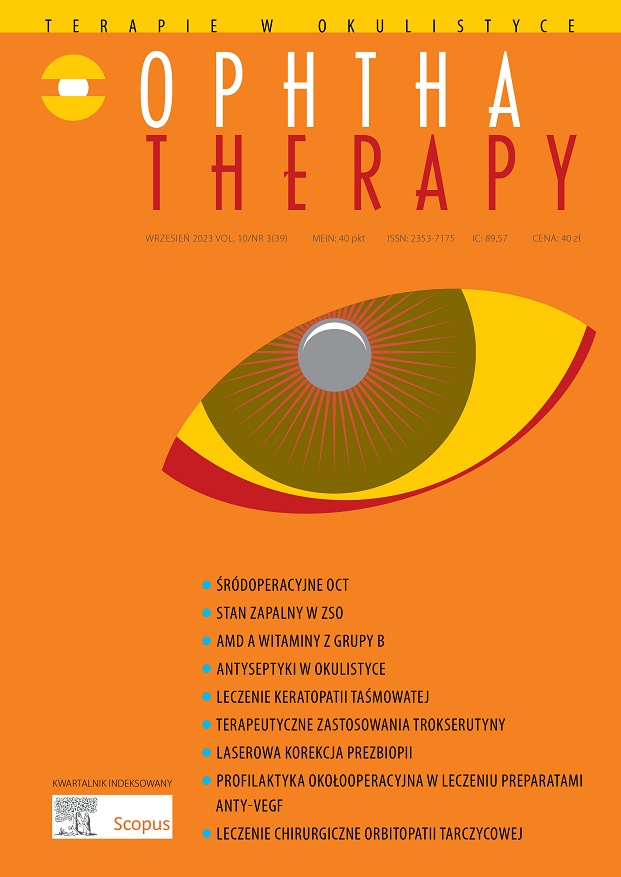Shall intraoperative OCT become standard equipment of modern operating room? Review article
Main Article Content
Abstract
The role of intraoperative OCT (iOCT) in ophthalmic surgery is still a matter of active research and enhancements to integrative technologies. Further research is necessary to better define the specific applications of iOCT that impact surgical decision-making and as such help to achieve better patient outcomes, both in anterior and in posterior segment of the eye. In time to come advancements in integrative systems, OCT-friendly instrumentation, and software algorithms will most likely expand the horizon of iOCT even further.
Downloads
Article Details

This work is licensed under a Creative Commons Attribution-NonCommercial-NoDerivatives 4.0 International License.
Copyright: © Medical Education sp. z o.o. License allowing third parties to copy and redistribute the material in any medium or format and to remix, transform, and build upon the material, provided the original work is properly cited and states its license.
Address reprint requests to: Medical Education, Marcin Kuźma (marcin.kuzma@mededu.pl)
References
2. Geerling G. Intraoperative 2-Dimensional Optical Coherence Tomography as a New Tool for Anterior Segment Surgery. Arch Ophthalmol. 2005; 123(2): 253. http://doi.org/10.1001/archopht.123.2.253.
3. Dayani PN, Maldonado R, Farsiu S et al. Intraoperative use of handheld spectral domain optical coherence tomography imaging in macular surgery. Retina. 2009; 29(10): 1457-68. http://doi.org/10.1097/IAE.0b013e3181b266bc.
4. Carrasco-Zevallos OM, Viehland Ch, Keller B et al. Review of intraoperative optical coherence tomography: technology and applications [Invited]. Biomed Opt Express. 2017; 8(3): 1607. http://doi.org/10.1364/boe.8.001607.
5. Lauer A, Vasconcelos H. Intraoperative OCT: an emerging technology. Eyenet Magazine. 2018; 31-3.
6. Gandorfer A, Haritoglou C, Kampik A. Toxicity of indocyanine green in vitreoretinal surgery. Dev Ophthalmol. 2008; 42: 69-81. http://doi.org/10.1159/000138974.
7. Ehlers JP, Modi YS, Pecen PE et al. The DISCOVER Study 3-Year Results: Feasibility and Usefulness of Microscope-Integrated Intraoperative OCT during Ophthalmic Surgery. Ophthalmology. 2018; 125(7): 1014-27. http://doi.org/10.1016/J.OPHTHA.2017.12.037.
8. Gao J, Hussain RM, Weng CY. Voretigene neparvovec in retinal diseases: A review of the current clinical evidence. Clin Ophthalmol. 2020; 14: 3855-69. http://doi.org/10.2147/OPTH.S231804.
9. Ehlers JP. Intraoperative optical coherence tomography: Past, present, and future. Eye (Basingstoke). 2016; 30(2): 193-201. http://doi.org/10.1038/eye.2015.255.
10. Ehlers JP, Uchida A, Srivastava SK et al. Predictive model for macular hole closure speed: Insights from intraoperative optical coherence tomography. Transl Vis Sci Technol. 2019; 8(1): 18. http://doi.org/10.1167/tvst.8.1.18.
11. Patel AS, Goshe JM, Srivastava SK et al. Intraoperative Optical Coherence Tomography-Assisted Descemet Membrane Endothelial Keratoplasty in the DISCOVER Study: First 100 Cases. Am J Ophthalmol. 2020; 210: 167-173. http://doi.org/10.1016/j.ajo.2019.09.018.
12. Khan M, Srivastava SK, Reese JL et al. Intraoperative OCT-assisted Surgery for Proliferative Diabetic Retinopathy in the DISCOVER Study. Ophthalmol Retina. 2018; 2(5): 411-7. http://doi.org/10.1016/j.oret.2017.08.020.
13.Ehlers JP, Srivastava SK, Feiler D et al. Integrative advances for OCT-guided ophthalmic surgery and intraoperative OCT: Microscope integration, surgical instrumentation, and heads-up display surgeon feedback. PLoS One. 2014; 9(8): e105224. http://doi.org/10.1371/journal.pone.0105224.

